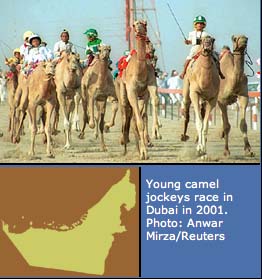High demand for Asian women and children as laborers, servants, prostitutes and camel jockeys.
Type: Destination Country
Background
The U.S. government classifies the United Arab Emirates as a turnaround story for human trafficking, but the essentials of what makes this oil-rich country an attractive market for traders remain in place. With a per capita income of $22,000 and within easy reach of South Asia and Africa, the UAE has a predominantly foreign population base with a high demand for cheap domestic servants, construction, and agricultural workers. But the industry that has attracted the most notice for use of trafficking victims is: camel racing.
Victims
Broadcast on UAE television and regularly attended by ruler Sheikh Zayed Bin Sultan Al Nahyan, camel races are a traditional form of entertainment for the UAE’s eight Emirates. (The UAE’s foreign minister, Sheikh Hamdan bin Zayid, who has called for a crackdown on the use of juvenile camel jockeys, is also the head of the country’s camel racing federation.) Light jockeys on prize-winning race camels (worth upwards of $1 million) are a key element for success in this multi-billion-dollar industry. Boys from Bangladesh and Pakistan — some as young as three — have traditionally been favored to meet this need. Traffickers will often travel to Bangladesh or Pakistan to purchase likely camel jockeys, or parents (whether real or traffickers posing as parents) will bring the children to the UAE for sale. The Bangladeshi National Women Lawyers Association reports that as many as 7,000 boys were smuggled out of Bangladesh for use in camel races in the 1990s. Other estimates have put the number of children taken out of Pakistan for UAE camel races at 30 per month. Though the use of camel jockeys younger than 15 was banned in 1980, children as young as three or four are still often used for racing, according to a recent investigation by the Australian Broadcasting Corporation. To guarantee cooperation, purchased children are routinely beaten or deprived of food. Unable to speak Arabic and too young to fend for themselves alone, the boys learn to comply.
But South Asian boys are not the only victims in the UAE. Women and girls put into domestic service in the Emirates reportedly come mostly from Sri Lanka, Indonesia, India, and the Philippines. Central Asian and Eastern European women are focused on the UAE’s sex industry. Unskilled laborers for construction jobs and fieldwork come from Pakistan, Afghanistan, India, and Bangladesh.
Counter-Trafficking Efforts
On paper, the UAE appears to be making progress in combating human trafficking. Inspections of private companies for enforced labor and blacklisting for violations are up; prosecutors and judges are required to study human rights, immigration, and labor law; biometrics are used to match work permits with permit holders.
But what the UAE says it has done to fight the use of juvenile camel jockeys conflicts strongly with reports compiled by outside, independent organizations. According to information presented in the 2003 U.S. Trafficking in Persons report, UAE government officials use DNA and medical tests to test the parenthood of those claiming supervision of child jockeys and routinely screen visitors at entry points into the country for children entering as jockeys. In September 2002, the government announced, to much fanfare, a ban on jockeys younger than 15 or who weighed less than 99 lbs. First-time violators are fined $5,500. Subsequent violations can lead to a one-year racing suspension and prison time.
The UN Human Rights Commission has noted, however, that the ban is essentially a restatement of a 23-year law that outlaws the employment of all child laborers. Prosecutions of violators of the ban have yet to occur, notes Anti-Slavery International. Video footage shot by the Australian Broadcasting Corporation in February 2003 showed that use of children for camel races still continues. After showing similar footage at an international conference, the International Labor Organization secured a visit to the UAE in late 2003 for further talks on the problem.
- Previous: Turkey
- Next: United Kingdom



